How do I use PBRS to export Power BI Reports & Dashboards, Paginated Reports, or SSRS reports to PDF?
Export Power BI, Paginated Reports, or SSRS reports to PDF & automatically deliver them to an FTP site, send them in emails, or deliver them to any number of other destinations. PBRS lets you customize them before delivery. Here's how.
Style
This article applies to:
- Power BI Reports & Dashboards (Cloud - Power BI Service)
- Power BI Paginated Reports (Cloud - Power BI Service)
- Power BI Reports & Dashboards (On Premise - Power BI Report Server)
- Power BI Paginated Reports (On Premise - Power BI Report Server)
- Microsoft SSRS Reports (On Premise - SQL Server Reporting Services)
- This video shows how to schedule Power BI Service Paginated Reports to Acrobat PDF.

Acrobat Format (*.pdf) Output Format
- To export to Acrobat Format (*.pdf) in Power BI Service Reports & Dashboards, Power BI Service Paginated Reports, Paginated Reports on Premise, and SSRS follow the following steps:
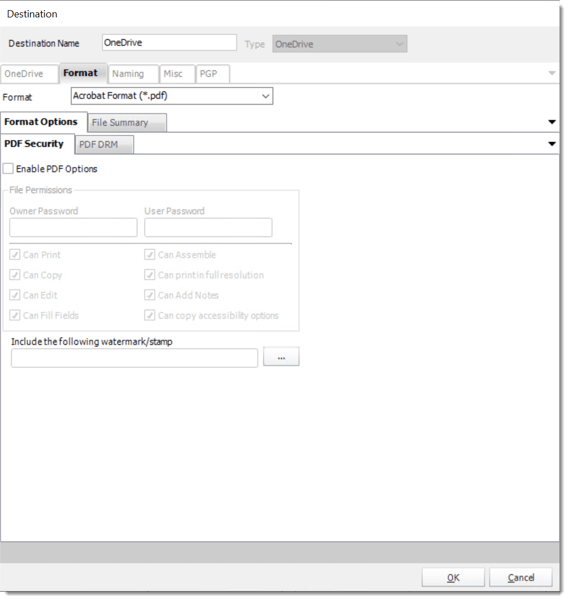
Format
The output format is selected as part of the Destinations setup for each destination type. The tab above can be found in the Destinations section of a schedule.
Format Options
- PBRS can export your report in PDF Format. Additionally, you can customize your PDF output by using the options below.
- Enable PDF options: You can enable extra PDF options. If you choose not to use the options, a standard pdf file will be exported.
- File Permissions: Enter passwords and select the options you require. Files will be encrypted using pdf 128 Bit encryption. The resulting files can only be opened with versions of Acrobat which can handle this level of encryption e.g. Acrobat 6 and above.
- Include the following watermark/stamp: You can include a watermark or stamp to be inserted in the PDF document. Click the (...) button for more options.
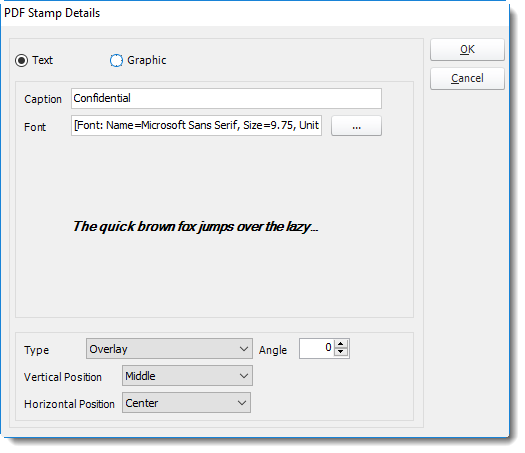
- Your Watermark can be a graphic such as a corporate logo.
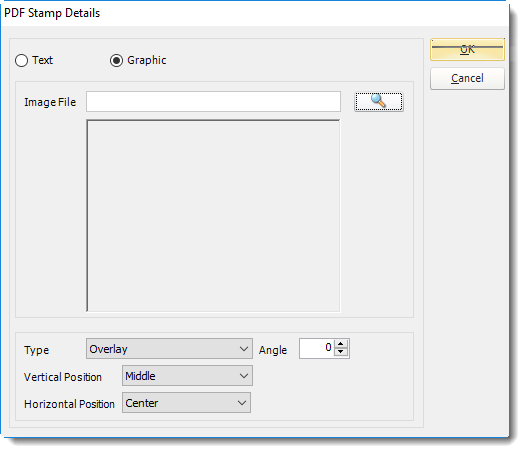
PDF DRM
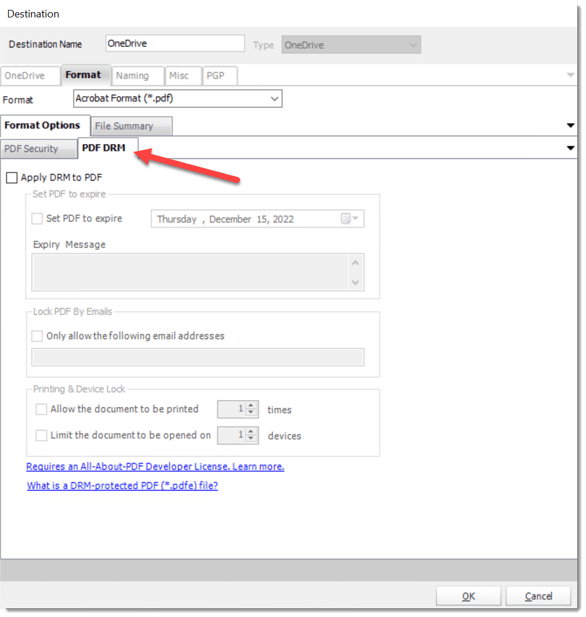
- Use this option to apply DRM protection to the PDF output files.
**Using this feature requires an All-About-PDF Developer License.
- This feature allows you to set the PDF to expire, lock the PDF by emails, and set a printing and device lock.
File Summary
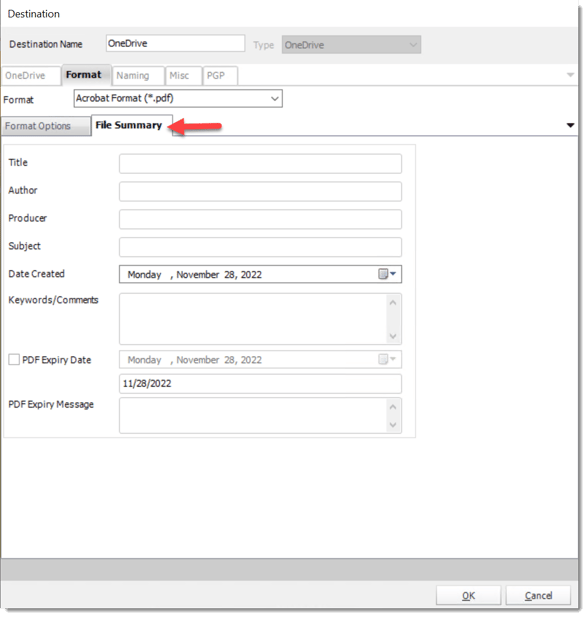
- Determine file summary by filling in the required properties as illustrated above.
- If properties are not filled in or are left blank, the original properties which exist in the exported report will be preserved. To overwrite these with a blank, enter a space in the field you wish to overwrite.
Naming
These options determine how the exported file will be named:
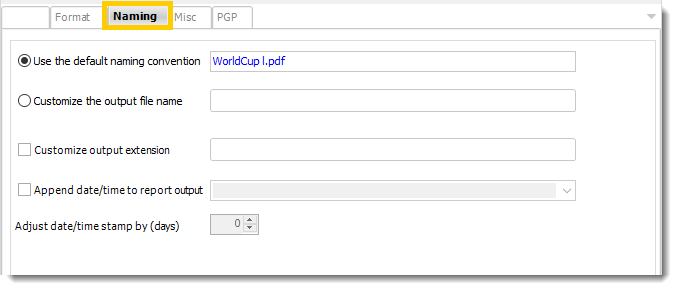
- This is the option where you named the output file.
- Default Naming Convention: PBRS will name the output file in the following format: reportname.format extension, e.g. Catalog Report.pdf.
- Customize the output file name: Choose your own filename or right-click and use the Insert Function to insert a value.
- Customize output extension: Choose your own extension. This is useful for system integration. For example, the default extension for a character separated file is "CSV," but you can give your export an extension of "txt" so that the file can be read by another already existing system you may have. You may also right-click and use the Insert Function to insert a value.
- Append date/time: This is useful for the following reasons:
- If the filename is the same each time, and it is being exported to the same folder each time, then it will be overwritten by the latest one each time. By appending date and time to the filename, each file remains unique, and no files are overwritten.
- You can track which reports ran and when they ran by looking at what the report is named.
Misc
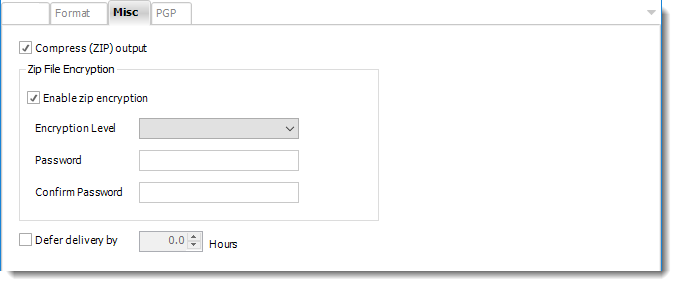
- Compress (ZIP) Output: Zips the output. Ability to use .zip encryption as well.
- Zip File Encryption: Check the option to encrypt and password protect the zip file.
- Defer Delivery: The report will be generated at the scheduled time, but will not be delivered to the specified destination until later.
- For more information, go to Deferred Delivery
PDF - Data Only (*.pdf) outputs for Power BI Service - Reports & Dashboards
- To export to PDF - Data Only (*.pdf) in Power BI Service follow the following steps:
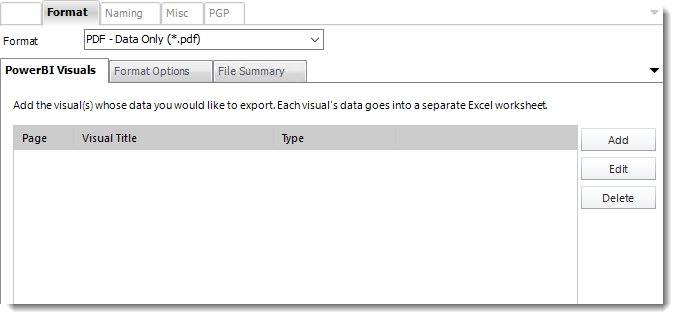
Format
The output format is selected as part of the Destinations setup for each destination type. The tab above can be found in the Destinations section of a schedule.
- PDF - Data Only exports data from specified visuals to PDF.
- To add visual data click Add.

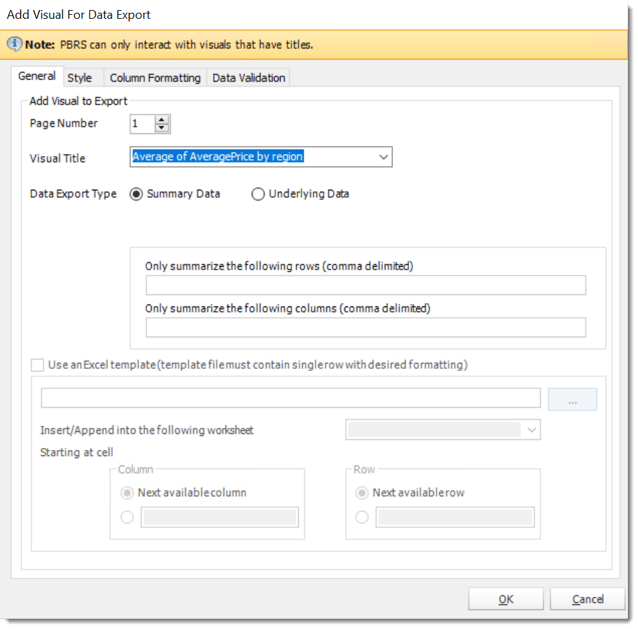
General
- Visual Title: Select the Visual data's titles you want to export.
In order for PBRS to see a Visual, the Visual MUST have a title already set in Power BI.
-
Data Export Type
-
Summarized data: Select this option if you want to export data for what you see in that visual.
-
Underlying data: Select this option if you want to see the data in the visual and additional data from the model.
For a more detailed explanation of the Data Export Types, click here.
Style
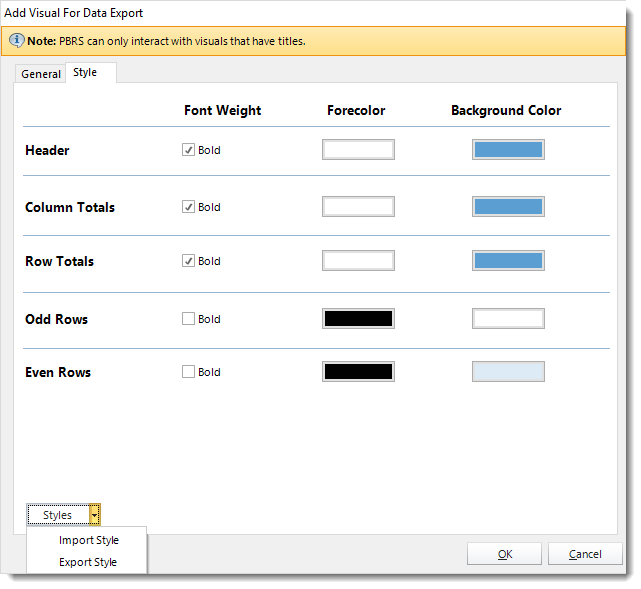
- In this section, you may modify the font-weight and colors of that visual.
- Styles: You can import and/or export styles to be used in other destinations and schedules.
This option can only be used in PDF - Data Only (*.pdf) for Power BI.
Column Formatting
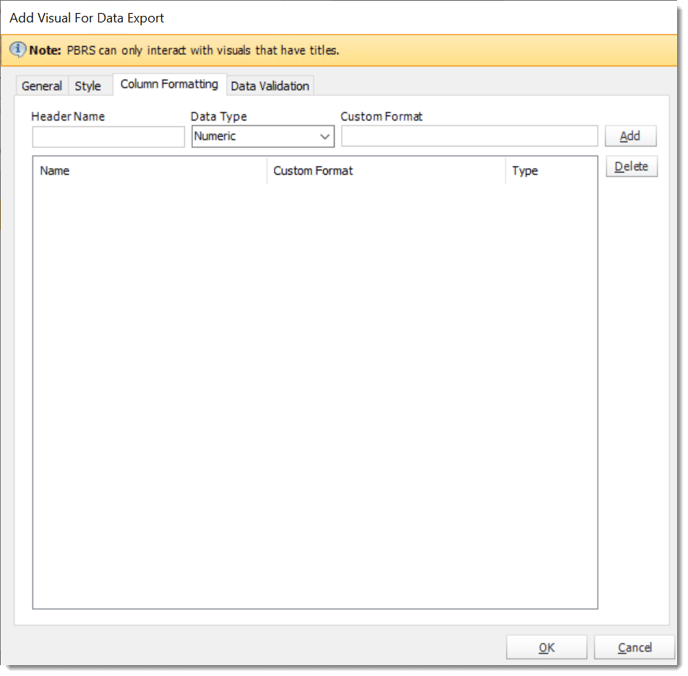
- In this section, you can format your columns in the PDF by entering the header name, data type, and the custom format.
Data Validation

- In this section, you can validate your data prior to delivery by checking this box.
- Click OK.
File Summary
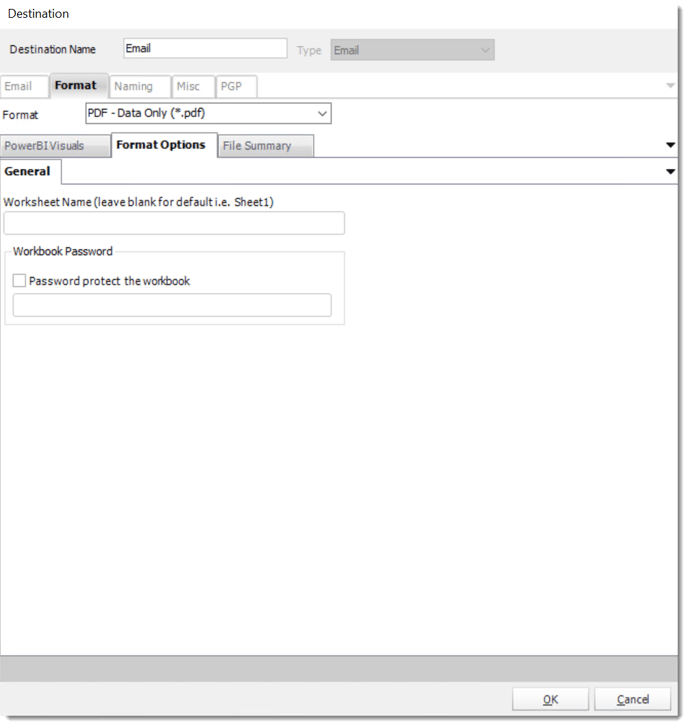
- In this section, you can give your worksheet a name, or you can password protect your workbook with a password of your choosing.
File Summary
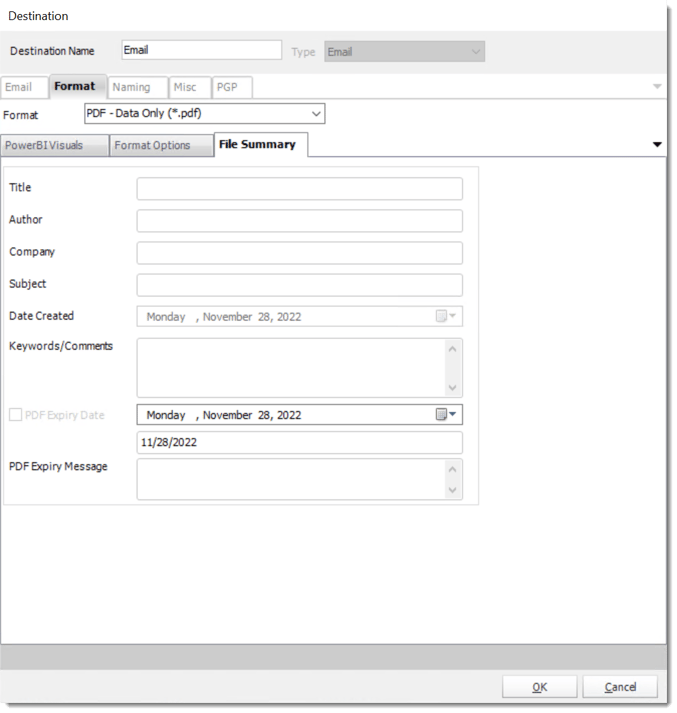
- Determine file summary by filling in the required properties as illustrated above.
- If properties are not filled in or are left blank, the original properties which exist in the exported report will be preserved. To overwrite these with a blank, enter a space in the field you wish to overwrite.
Naming
These options determine how the exported file will be named:
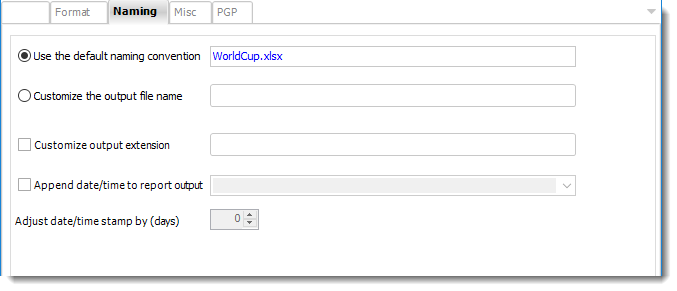
- This is the option where you name the output file.
- Default Naming Convention: PBRS will name the output file in the following format: reportname.format extension, e.g. Catalog Report.pdf.
- Customize the output file name: Choose your own filename or right-click and use the Insert Function to insert a value.
- Customize output extension: Choose your own extension. This is useful for system integration. For example, the default extension for a character separated file is "CSV," but you can give your export an extension of "txt" so that the file can be read by another already existing system you may have. You may also right-click and use the Insert Function to insert a value.
- Append date/time: This is useful for the following reasons:
- If the filename is the same each time, and it is being exported to the same folder each time, then it will be overwritten by the latest one each time. By appending date and time to the filename, each file remains unique, and no files are overwritten.
- You can track which reports ran and when they ran by looking at what the report is named.
Misc
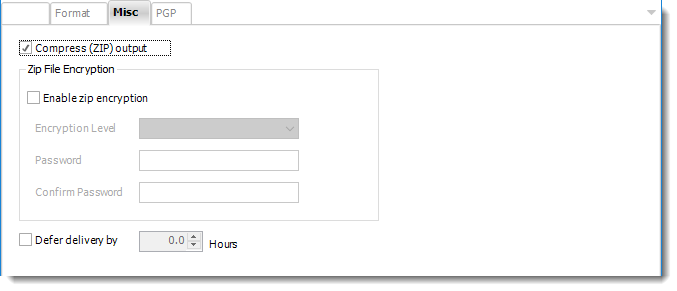
- Compress (ZIP) Output: Zips the output. Ability to use .zip encryption as well.
- Zip File Encryption: Check the option to encrypt and password protect the zip file.
- Defer Delivery: The report will be generated at the scheduled time, but will not be delivered to the specified destination until later.
- For more information, go to Deferred Delivery